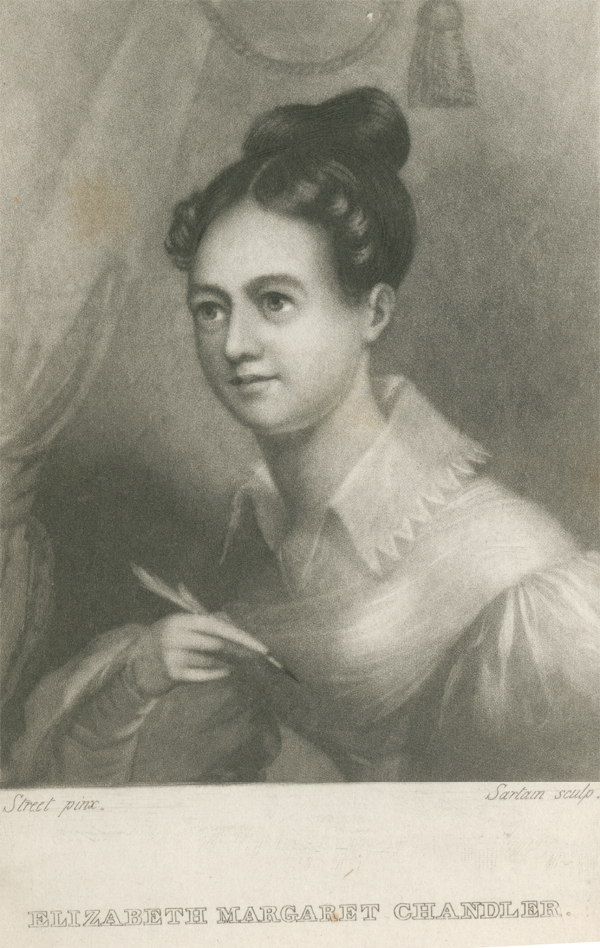- Elizabeth Margaret Chandler
Infobox Person
name = Elizabeth Margaret Chandler

image_size = 200px
caption = "Elizabeth Margaret Chandler, The Poetical Works" (pub. 1836) - frontispiece
birth_date = birth date|1807|12|24|mf=y
birth_place = Centre,Delaware
death_date = death date and age|1834|11|2|1807|12|24|mf=y
death_place =Michigan
occupation =Writer
spouse =
parents =
children =Elizabeth Margaret Chandler (
24 December ,1807 –2 November ,1834 ) was a noted poet and writer ofPennsylvania andMichigan . She became the first woman writer in America to make the abolition ofslavery her principal themecite web|url=http://hall.michiganwomenshalloffame.org/honoree.php?|title=Chandler page|work= Michigan Women Hall of Fame site|accessmonthday=December 26| accessyear=2006] , before she died at age twenty-six.Early life
Elizabeth Margaret Chandler was born in Centre,
Delaware , onChristmas Eve , 1807cite web|url=http://worldconnect.rootsweb.com/cgi-bin/igm.cgi|title=Chandler page| publisher =Rootsweb.com | work = WorldConnect Project|accessmonthday=December 26|accessyear=2006] to Thomas Chandler (1773–1817) and Margaret Evans (1778–1808). She had two older brothers, William Guest Chandler (1804–1873) and Thomas Chandler (1806–?). They were members of theReligious Society of Friends (or Quakers), and they lived the strict, orderly and disciplined life of a Quaker family.By the time she was nine years old she had lost both her parents, she and her brothers were living with their grandmother, Elizabeth Guest Evans (1744–1827), in
Philadelphia ,Pennsylvania . Elizabeth attended a Quaker school and there embraced the Quaker view of antislavery. Elizabeth started writing poems at a very early age. She left school when she was about twelve or thirteen (sources differ), but continued to read and write with a passion.cite web|url=http://dqc.esr.earlham.edu:8080/xmlmm/docButton?XMLMMWhat=hitPage&XMLMMWhere=hit&XMLMMHitNumber=5&XMLMMBuilt=Y&XMLMMBeanName=toc1&XMLMMNextPage=/printBuiltPage.jsp|title=Memoirs|work=Earlham School of Religion, Digital Quaker Collection|accessmonthday=December 26|accessyear=2006]Career
At the early age of sixteen, Elizabeth Chandler's romantic verses on nature were first published. In 1825, when she was eighteen years old, her emotional poem, "", was published and drew national attention. After reading that poem, she was invited by
Benjamin Lundy , a well known abolitionist and publisher, to write for his periodical, TheGenius of Universal Emancipation . She wrote for and edited the "Ladies' Repository" section of his newspaper. She used her appeal to women to demand better treatment for Native Americanscite web|url=http://www.librarycompany.org/women/portraits/chandler.htm|title=Chandler page, American Women Writers|work=Library Company site|accessmonthday=December 27|accessyear=2006] and the immediateemancipation of slaves. She became one of the most powerful women writers of her time. She often used the tragic example of women slaves being torn away from their children and their husbands to gain sympathy from her female readers. When told that women did not have the power to abolish slavery, Chandler responded that, as mothers, women are in the unique position: It is hard to say exactly how influential her writings were to the public at large. However, many of her articles were copied and circulated in the most popular newspapers of the time. She also introduced one of the most famous abolitionist images, the kneeling female slave with the slogan "Am I not a Woman and a Sister".cite web|url=http://www.dar.org/museum/exhibitions.cfm|title=Virtual Exhibitions - artifacts of the Abolitionist movement page|work=Daughters of the American Revolution site|accessmonthday=December 27|accessyear=2006] Two years later,William Lloyd Garrison editor of "The Liberator ", and a leader in the abolitionist movement, adopted this symbol and slogan to head the ladies department of the paper, one of the most prominent abolitionist papers of the time.Sojourner Truth also adopted the slogan for her famous speech of 1851.Move to Michigan
In 1830, Elizabeth Margaret Chandler moved, with her aunt and brother, to the territory of Michigan. Her brother Thomas Chandler purchased land near
Tecumseh, Michigan inLenawee County , about sixty miles south-west ofDetroit , in order to start a farm. They called the place Hazlebank."From this, her quiet and secluded retreat, emanated some of the choicest productions of her pen." --
Chandler participated in national discussions and debates through her articles and poems about Abolitionism. She continued to edit Benjamin Lundy's Abolitionist Journal.cite web|url= http://www.abebooks.com/servlet/BookDetailsPL?bi=736579866&tab=1&searchurl=isbn%3D0870137131%26sortby%3D2| title= "Remember the Distance That Divides Us" book details|work=ABE books site|accessmonthday=December 27|accessyear= 2006]Benjamin Lundy While living in Philadelphia, Chandler had been a member of a Female Anti-Slavery Society, although she was not very active. After she moved to Michigan, she established the Logan Female Anti-Slavery Society in 1832 with her friend and neighbor
Laura Smith Haviland . She wrote:"Terrible in crime and magnitude as the slavery of our country is, I do not despair — apathy must — will awaken, and opposition die — the cause of justice must triumph, or our country must be ruined."
The Logan Female Anti-Slavery Society organization established a main link in theUnderground Railroad toCanada .Death
Elizabeth Margaret Chandler died from "remittent fever" on
November 2 ,1834 , shortly before her 27th birthday. She was buried near the family farm at Hazlebank. Her articles, poems, and letters were gathered and published as two books, byBenjamin Lundy , and the proceeds from the sale of those books went to the cause of abolition.References
External links
* Michigan Women's Hall of Fame [http://hall.michiganwomenshalloffame.org/honoree.php?C=36&A=20~114~96~172~79~2~62~113~46~80~3~152~167~74~138~63~92~196~4~32~121~84~48~153~192~41~129~82~69~109~42~93~97~56~175~103~13~207~21~126~104~5~98~131~27~53~38~195~139~219~106~57~22~147~58~107~127~6~173~144~85~17~148~47~208~49~221~43~205~135~168~181~33~115~176~23~14~75~169~130~162~44~198~204~99~7~118~119~8~136~222~50~15~157~65~150~108~24~154~170~163~76~9~209~110~140~70~59~51~155~16~158~156~60~182~191~116~190~28~164~125~160~197~86~193~223~29~134~39~159~111~61~177~132~87~52~199~54~35~210~211~64~112~200~183~165~100~10~122~71~77~94~120~11~36~25~224~151~178~55~88~45~184~128~72~78~171~141~180~206~189~73~123~83~89~145~18~66~26~30~212~188~142~220~90~19~40~161~218~133~81~225~67~37~146~217~91~143~12~31~68~1~213~101~117~214~174~102~137~185~124~95~216~166~187 Chandler page] .
* [http://worldconnect.rootsweb.com/cgi-bin/igm.cgi Birthdays and dates of death] .
* Daughters of the American Revolution [http://www.dar.org/museum/exhibitions.cfm exhibitions site] , for image of Chandler's pin box and purse with the famous "Kneeling female slave" meme.
* [http://www.abebooks.com/servlet/BookDetailsPL?bi=736579866&tab=1&searchurl=isbn%3D0870137131%26sortby%3D2 ABE books] .Further reading
* Marcia J. Heringa Mason, editor. "Remember the Distance That Divides Us: The Family Letters of Philadelphia Quaker abolitionist and Michigan pioneer Elizabeth Margaret Chandler, 1830–1842". Michigan State University Press, July 2004. ISBN 978-0870137136
Books by Chandler
* "Essays, Philanthropic and Moral" - Publisher: Lemuel Howell (1836)
* "The poetical works of Elizabeth Margaret Chandler: With a memoir of her life and character" - Publisher: Lemuel Howell (1836) ASIN: B0008BINBEPersondata
NAME=Chandler, Elizabeth Margaret
SHORT DESCRIPTION=Abolitionist, Writer
DATE OF BIRTH=December 24 1807
PLACE OF BIRTH=Centre, Delaware
DATE OF DEATH=November 2 1834
PLACE OF DEATH=Lenawee County, Michigan
Wikimedia Foundation. 2010.
